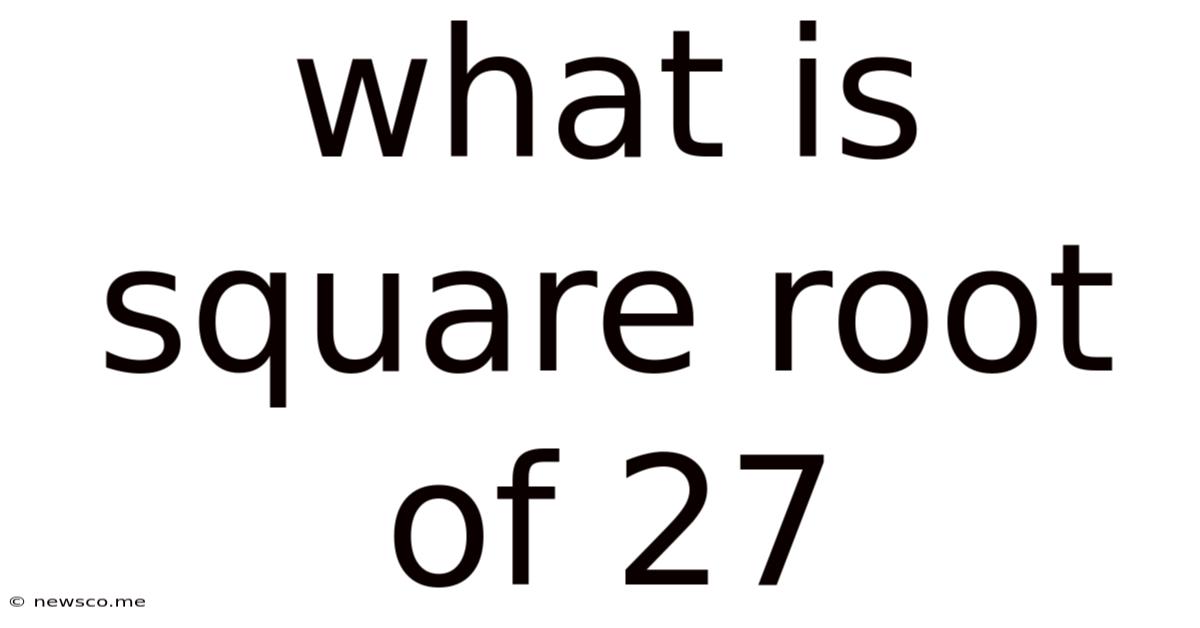What Is Square Root Of 27
News Co
Apr 15, 2025 · 4 min read

Table of Contents
What is the Square Root of 27? A Deep Dive into Square Roots and Simplification
The question "What is the square root of 27?" might seem simple at first glance, but it opens the door to a fascinating exploration of square roots, prime factorization, and simplifying radical expressions. This comprehensive guide will delve into the intricacies of finding the square root of 27, providing a clear understanding of the process and its underlying mathematical principles. We'll cover everything from basic definitions to advanced simplification techniques, ensuring a thorough grasp of this fundamental concept.
Understanding Square Roots
Before tackling the square root of 27, let's establish a firm understanding of what a square root actually is. The square root of a number is a value that, when multiplied by itself, equals the original number. For instance, the square root of 9 is 3 because 3 multiplied by 3 (3²) equals 9. This is represented mathematically as:
√9 = 3
This concept extends to all non-negative real numbers. However, things get slightly more complex when dealing with numbers that aren't perfect squares – numbers that don't have an integer as their square root. This is precisely where the square root of 27 falls.
Prime Factorization: The Key to Simplifying Radicals
To simplify the square root of 27, we need to employ a powerful tool: prime factorization. This technique involves breaking down a number into its prime factors – numbers divisible only by 1 and themselves. Let's break down 27:
27 = 3 x 9 = 3 x 3 x 3 = 3³
Therefore, the prime factorization of 27 is 3³.
Simplifying the Square Root of 27
Now, let's apply this prime factorization to simplify √27. Remember that we're looking for pairs of identical factors within the radical because a pair of identical factors multiplied together forms a perfect square.
√27 = √(3³)= √(3² x 3)
Since 3² is a perfect square, we can take it out of the radical:
√(3² x 3) = √3² x √3 = 3√3
Therefore, the simplified square root of 27 is 3√3. This means that 3√3 multiplied by itself equals 27.
Approximating the Value of 3√3
While 3√3 is the exact simplified form, we might want an approximate decimal value. Since √3 is approximately 1.732, we can calculate:
3√3 ≈ 3 x 1.732 ≈ 5.196
So, the square root of 27 is approximately 5.196. However, remember that 3√3 is the exact, simplified form, and using the decimal approximation introduces a small degree of error.
Understanding Different Types of Square Roots
It's important to note that the square root of a number can be either positive or negative. However, the principal square root (often denoted by √) is always the non-negative root. Therefore, while both 3√3 and -3√3 squared equal 27, only 3√3 is considered the principal square root.
This distinction is crucial in various mathematical contexts and ensures consistency in calculations.
Beyond 27: Exploring Other Square Roots
The method of simplifying square roots using prime factorization applies to many other numbers. Let's examine a few examples:
- √12: 12 = 2² x 3, so √12 = √(2² x 3) = 2√3
- √48: 48 = 2⁴ x 3, so √48 = √(2⁴ x 3) = √(2² x 2² x 3) = 2 x 2 √3 = 4√3
- √75: 75 = 3 x 5², so √75 = √(3 x 5²) = 5√3
- √108: 108 = 2² x 3³, so √108 = √(2² x 3² x 3) = 2 x 3√3 = 6√3
Notice the pattern: we simplify by finding pairs of factors within the radical. Each pair contributes one factor outside the radical, while any unpaired factors remain inside.
Practical Applications of Square Roots
Square roots are not just abstract mathematical concepts; they have numerous practical applications in various fields:
- Geometry: Calculating the lengths of diagonals in squares, rectangles, and other shapes. The Pythagorean theorem, a cornerstone of geometry, heavily relies on square roots.
- Physics: Determining speed, velocity, and other related quantities. Many physical formulas involve square roots.
- Engineering: Designing structures, calculating distances, and solving various engineering problems.
- Finance: Calculating compound interest and other financial calculations.
- Computer Graphics: Creating realistic images and animations.
Further Exploration: Cube Roots and Beyond
While we've focused on square roots, the concept extends to higher-order roots, such as cube roots (∛), fourth roots (∜), and so on. A cube root is a value that, when multiplied by itself three times, equals the original number. Similarly, a fourth root is a value that, when multiplied by itself four times, equals the original number. The same principle of prime factorization can be used to simplify these higher-order roots as well.
Conclusion: Mastering the Square Root of 27 and Beyond
Understanding the square root of 27, and the process of simplifying square roots in general, is a crucial step in mastering fundamental algebraic concepts. The method of prime factorization provides a powerful and systematic approach to simplifying radical expressions, ensuring accurate and efficient calculations. This understanding extends beyond simply finding the numerical value and unlocks a deeper appreciation for the mathematical principles underlying these seemingly simple calculations, opening doors to more advanced mathematical concepts and their various real-world applications. Remember that while the approximate decimal value is useful in certain contexts, the simplified radical form, 3√3, represents the precise and elegant solution to the square root of 27.
Latest Posts
Related Post
Thank you for visiting our website which covers about What Is Square Root Of 27 . We hope the information provided has been useful to you. Feel free to contact us if you have any questions or need further assistance. See you next time and don't miss to bookmark.